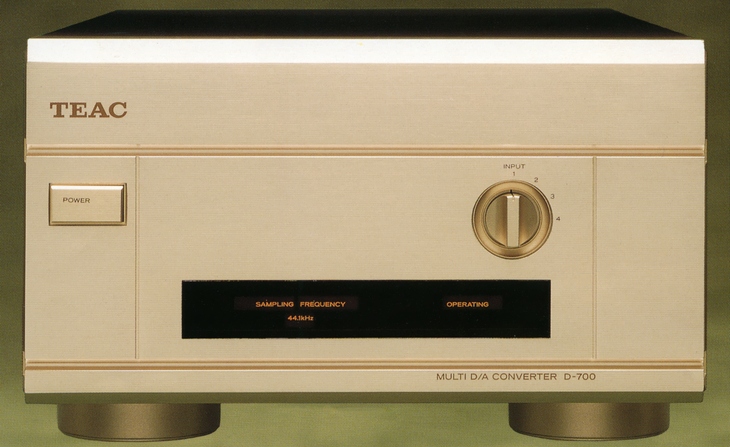
TEAC D-700
¥ 100,000 (around 1992)
Commentary
D/A converter paired with CD Transport P-700.
ZDII is used for the D/A conversion circuit.
In the case of a D/A converter, especially when the signal level is less than -60dB or when the signal changes slowly, a conversion error occurs and the resulting distortion occurs.
The Distortion Shaper ZDII uses a dither method to disperse and sharply reduce the conversion errors of the D/A converter, achieving a remarkably low distortion rate. In addition, it uses a unique wide-area concentrated (high-pass) dither to obtain an extremely high S/N ratio. This improves the reproducibility of small signals and the expressive power of the double Otonari component superimposed on a large volume signal.
The digital filter uses a 20-bit 8 x oversampling digital filter.
This allows the use of a low-pass filter with a moderate cutoff characteristic, thereby improving the group delay characteristics.
The D/A conversion section is equipped with a 1/16 shift 20-bit 4 dac.
This DAC employs a 1/16 (digital offset) small-signal-oriented DAC that eliminates the MSB error that normally occurs near 0 V. By shifting the 0 V operating point of the DAC by 1/16 of full scale, the 0 cross distortion that occurs when the input code passes 0 V is reduced to 1/8 of the conventional method.
This dramatically improves the linearity of the signal area (-18dB or less) where music signals are concentrated.
A cut-core balanced winding transformer is used for the power supply. In this transformer, the magnetic field is canceled by dividing the windings into two equal parts with opposite phases, and harmful electromagnetic noise is minimized. In addition, since the windings are arranged in parallel, self-inductance and DC resistance are reduced and excellent regulation is obtained.
In addition, the positive and negative balanced power supply section is composed of independent windings of the positive and negative power supply to clarify the ground potential.
Balanced transmission has been adopted for main parts such as digital transmission and analog transmission.
By transmitting not only positive-phase signals but also negative-phase signals simultaneously, contamination of the ground line with noise is canceled.
It uses not only key devices but also originally developed audio-only parts including capacitors and resistors.
The power supply section is equipped with a bridge rectifier circuit, and uses a power supply condenser equivalent to the Esotheric reference series at that time. Moreover, the double-sided shielded PCB board suppresses the generation of high-frequency noise that adversely affects sound quality.
A copper-plated rear panel is used to eliminate the potential difference between input and output that occurs during D/A conversion. The S/N ratio is 6 dB outside the audible band and 1 dB within the band.
Model Rating
| Type | D/A converter |
| Audio channel | 2 Channel |
| Frequency characteristic | 0 ~ 20 kHz ± 0.3 dB (RCA, 44.1 kHz) 5 Hz to 20 kHz ± 0.3 dB (XLR, 44.1 kHz) |
| Signal-to-noise ratio | 110dB(EIAJ) |
| Dynamic range | 100dB(EIAJ) |
| Harmonic distortion factor | 0.0015%(EIAJ) |
| Channel separation | 110dB(EIAJ) |
| Analog output | RCA : 2.1Vrms/47k Ω XLR : 2.0Vrms/600 Ω |
| Digital input | Coaxial : 0.5Vp-p/75 Ω, 2 systems Light : 2 systems |
| D/A converter | 1/16 shift 20-bit 4 dac |
| Digital filter | 20-bit 8 x oversampling |
| Analog filter | GIC third order Butterworth filter |
| Pwer | 100 VAC, 50Hz/60Hz |
| Power consumption | 14W |
| External dimensions | Width 225x Height 138x Depth 400 mm |
| Weight | 6.0kg |
.jpg)
.jpg)
.jpg)
.jpg)